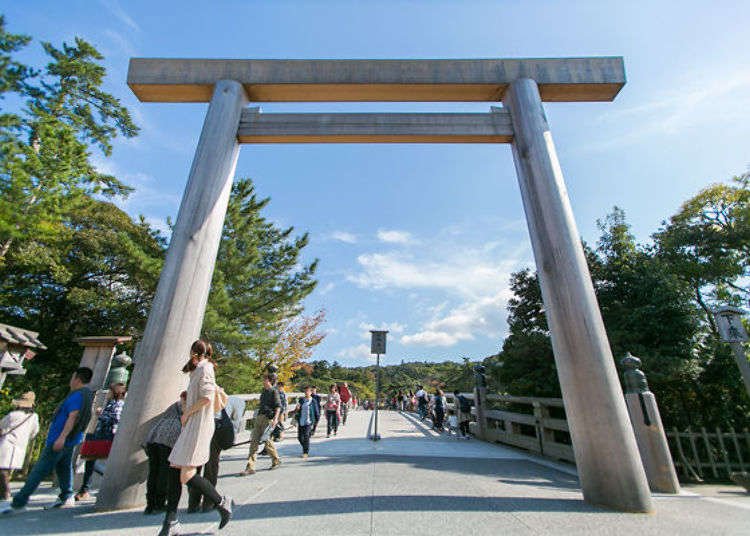
Nestled in the heart of Ise City, Mie Prefecture, the Ise Grand Shrine is considered the most sacred and prestigious of all the shrines in Japan.
With a rich history dating back over a thousand years, this spiritual sanctuary attracts worshipers and visitors from across the globe, who come to pay their respects and admire the shrine's unique architecture and breathtaking natural surroundings.
In this guide, we'll explore everything you need to know to make the most of your visit to the Ise Grand Shrine.
Entry is from the Outer Shrine of Ise
Ise Grand Shrine is not just one shrine; it consists of multiple shrines. The Inner Shrine, also known as Kotai Jingu, is where Amaterasu Omikami, the ancestor of the Imperial Family, is enshrined. The Outer Shrine, Toyoke Daijingu, enshrines Toyoke Omikami, the guardian deity of clothing, food, and shelter. There are a total of 125 shrines in Ise Grand Shrine, with the Inner and Outer Shrines being the main ones. The official name of Ise Grand Shrine is "Shrine."
In addition to the shrines, there is also a Shrine Forest that covers an area of about 5,500 hectares, roughly equivalent to the size of Manhattan.
To visit the Outer and Inner Shrines, the author was guided by Mr. Nobuyuki Nishida of the O-Ise-san Tour Guide Group. This group comprises volunteer guides showing visitors around the Ise Grand Shrine. Their services are usually free, but reservations are required, and there is a 1,000 yen charge for the guide's transportation if needed. If their services are retained during the lunch hour, another 1,000 yen is required for their meal.
As for the order in visiting the shrines, in most cases, the customary practice is to start with the Outer Shrine and then go to the Inner Shrine, so we began by going to the Outer Shrine.
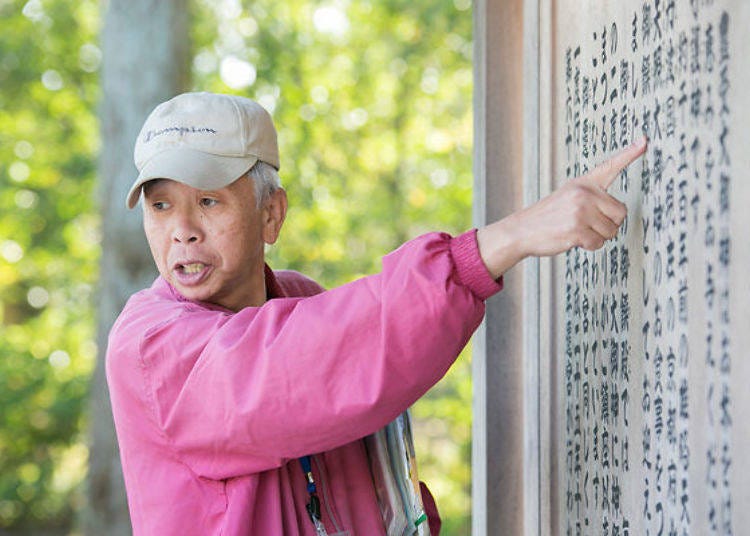
The guided tour begins at the signboard in front of the Omotesando Hiyokebashi, which is the entrance to the Outer Shrine.
“Well, can you see the word Mike (pron. ‘mi-kay’) written here? Mike is food that is offered to the gods. About 1,500 years ago, Toyoke Omikami, the god entrusted with offering food to Amaterasu Omikami, enshrined in the Inner Shrine, came here. That’s what is written here.”
Mr. Nishida enthusiastically explained while showing me a copy of documents he made containing quotations from the Nihon Shoki. He explained in detail the history of the Imperial Family and that of the Ise Grand Shrine.
After crossing the Hiyokebashi Bridge we first went to the Temizusha.
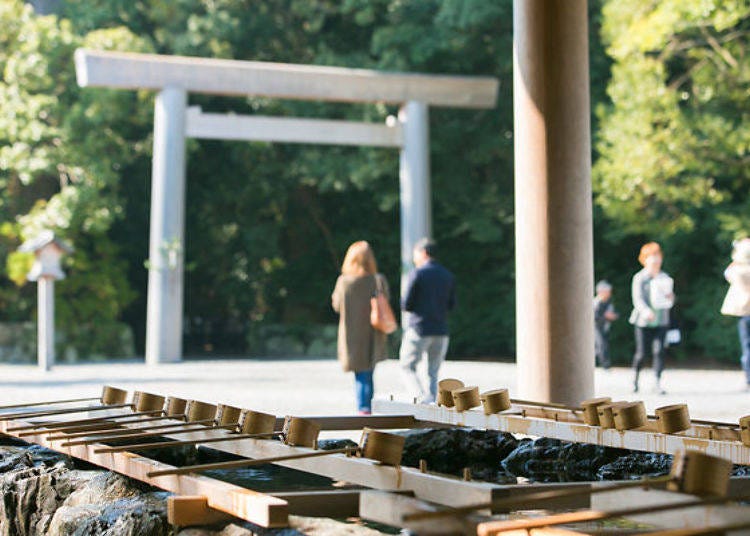
Mr. Nishida explained the purification process that visitors must undergo before entering a shrine beginning at the Temizusha, a dedicated building for cleaning hands and rinsing one's mouth.
First, visitors must take a ladle with their right hand and scoop up water. They then pour the water over their left hand before taking the ladle with their left hand to pour water over their right hand.
Next, visitors take the ladle with their right hand again and pour water into the palm of their left hand. They then take the water into their mouth before rinsing their left hand once more. Finally, visitors hold the ladle in a vertical position to allow the water to run down and wash the handle section before returning the ladle.
Unfortunately, it appears that many visitors nowadays are unaware of this proper purification procedure. Therefore, Mr. Nishida emphasized the importance of remembering how to perform this ritual correctly.
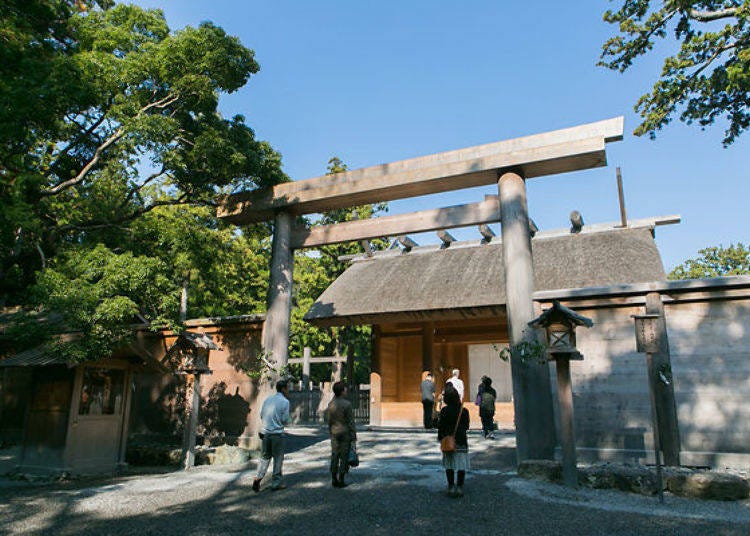
This is the Main Shrine of the Toyoke Daijingu (Outer Shrine). The Mikeden in the rear is where food offerings are given to Amaterasu Omikami and other gods. Twice daily, once in the morning and then again in the evening, a ceremony for offering food to the gods called Shinsen is conducted. I was amazed to learn that this ceremony has been conducted from 1,500 years ago. It has been continued through typhoons and wars for more than 1,500 years.
Hearing that impressed upon me all the more the special nature of this place.
-

-
Address
279, Toyokawacho, Ise-shi, Mie, 516-0042
View Map -
Nearest Station
Iseshi Station (JR Sangu Line)
9 minutes on foot
- Phone Number 0596-24-1111
-
Address
279, Toyokawacho, Ise-shi, Mie, 516-0042
Going to the Inner Shrine
Next we headed to the Inner Shrine at Ise Grand Shrine. The distance from the Outer Shrine is about 15 minutes by car.
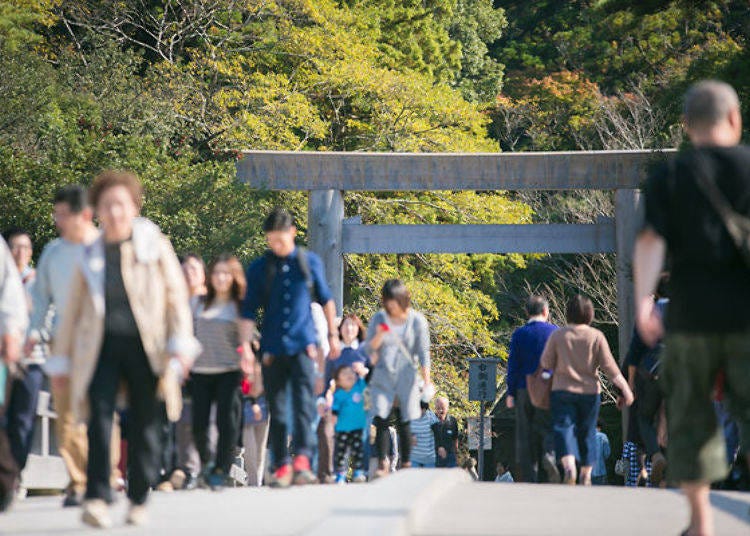
The Uji Bridge is a Japanese-style bridge built of cypress that spans the Isuzu River and is a symbolic place said to be the front entrance to the Inner Shrine. Magnificent Torii gates stand at both ends of it
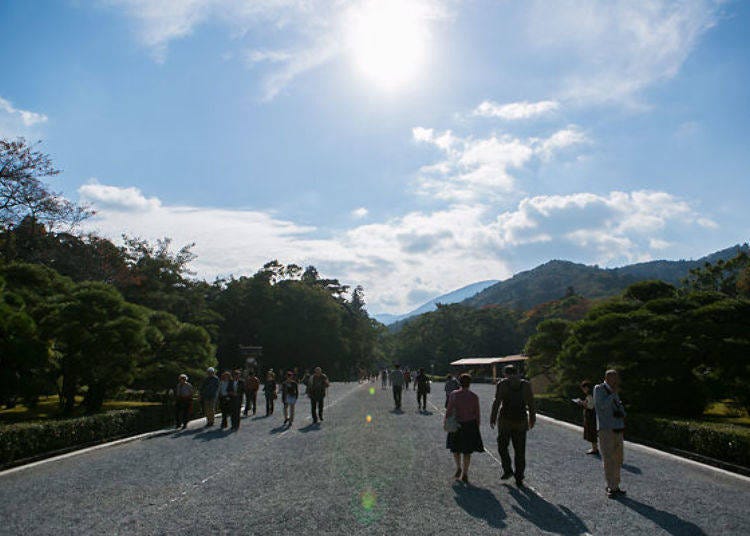
After crossing over the Uji Bridge and going through the Shin’en we came upon another Temizusha. Just as we did at the Outer Shrine we once again performed the purification ritual. Going further in and down a gently inclined bank to the right of the approach path, we came to the Mitarashi on the bank of the Isuzu River.
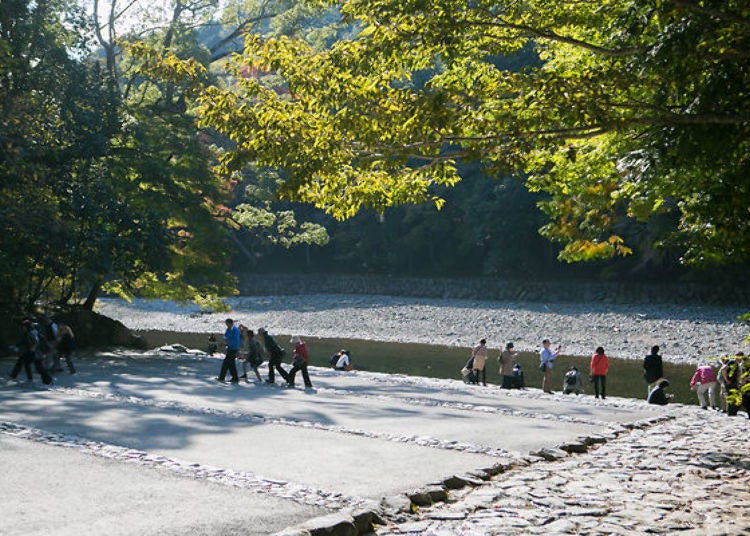
“In olden times before the Temizusha was constructed, this is where worshipers came to purify themselves. Yamatohime no Mikoto, who was traveling in search of a place to enshrine Amaterasu Omikami, rinsed the hem of her garment here, according to legend. From this legend, the Isuzu River also came to be called the Mimosusogawa,” Mr. Nishida explained.
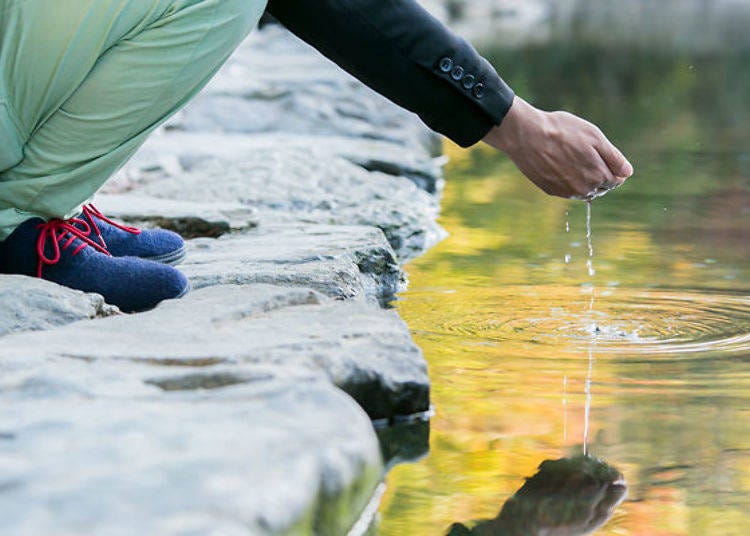
“The river is extremely clear because it flows from the upper reaches of the Inner Shrine.”
Normally if you have performed the purification ritual at the Temizusha, you need not do it again here. But since I was here, I once again performed the ritual here at the Isuzu River, the place of Yamatohime-no-Mikoto legend.
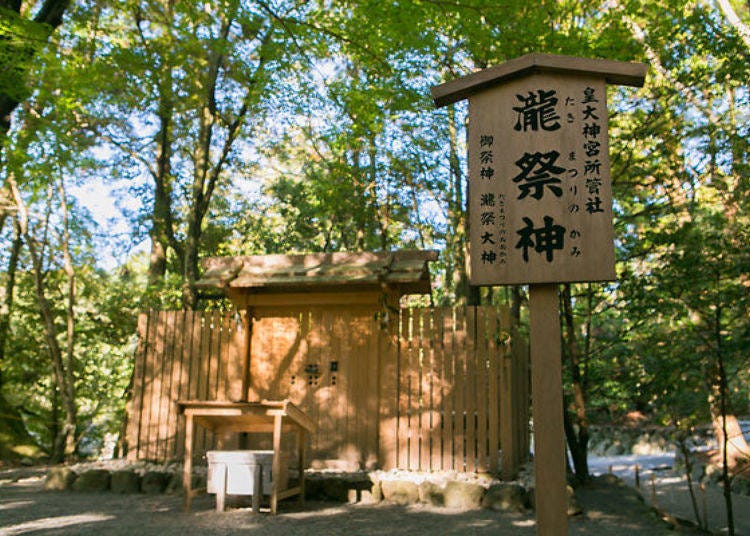
Let me introduce another style of worship. After purifying our hands at the Isuzu River Mitarashi, instead of returning to the approach to the shrine, Mr. Nishida led me down a narrow path.
“This is the Takimatsuri-no-Kami. Today "Taki" refers to a waterfall, but in the old days, rivers were also called "taki". That is to say, the deity of the Isuzu River is enshrined here. It may be small, but it is a very important place because even before Amaterasu Omikami came here, it was where the river god was."
Locally it is called Tottsukisan and Toritsugisan. "Takimatsuri no Kami was the place where worshipers came to offer their names, addresses, and from where they came to worship before they proceeded to the Inner Shrine." From that, it appears that Takimatsuri no Kami was a sort of intermediary for Amaterasu Omikami.
If you come here, by all means, please seek the intermediary blessings of Tottsukisan before proceeding on to the Inner Shrine.
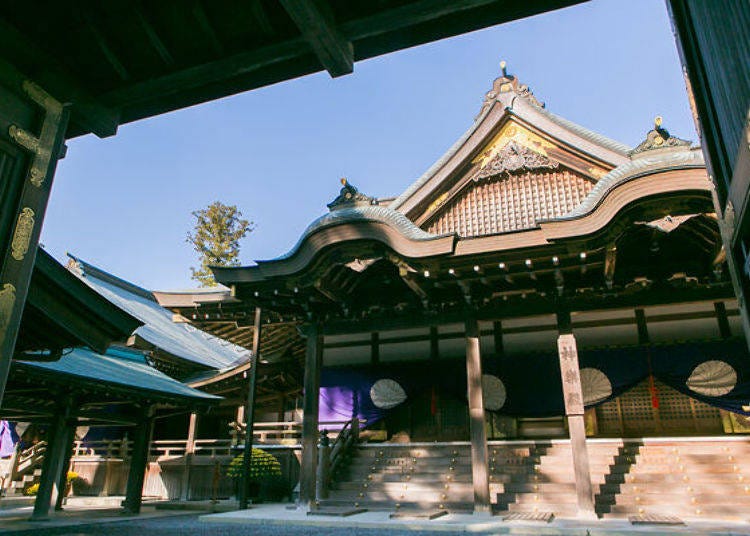
Returning to the approach to the shrine, after a bit we came to the Kaguraden. This is a place where you can give offerings, purchase amulets, and receive prayers. You can also get a commemorative scarlet seal of your visit to the Inner Shrine here.
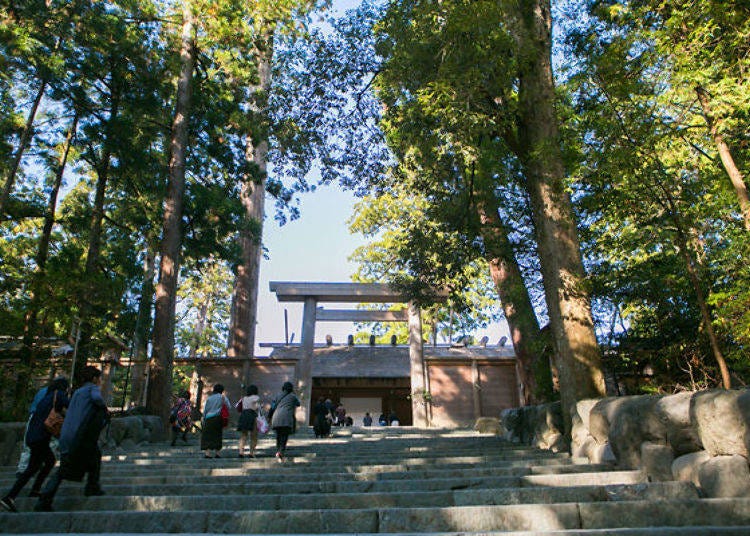
Finally, we arrived at the Main Shrine of the Inner Shrine. “Shrines have offering boxes in front of them, but you do not have to give an offering here,” Mr. Nishida explained, because the one here is not for making wishes, but for making offerings of gratitude.
In the first place, tribute paid by anyone other than the Emperor is not recognized, so for that reason, there is no offering box placed here. However, during the first visit to a shrine in the New Year, there are many worshipers who wish to give monetary offerings, so an offering box is set up temporarily for that.
Now let me explain how to worship. The standard method of worship when visiting a shrine is to bow twice, clap your hands twice, and bow once more.
First, you bow your head twice. Then you clap your hands twice. The main point when clapping your hands together is to make sure that your right hand is slightly lower than the left hand.
“Clapping your hands is a request to the god to listen to what is in your heart. If you clap your hands so that the palms are exactly aligned, the sound of the clap is not so clear, and also the left hand represents the god while the right hand represents you, so having the right hand lower is a sign of respect,” Mr. Nishida explained.
I managed to do it perfectly. You can convey your gratitude to the gods in this way for the daily protection you receive.
-

-
Address
1, Ujitachicho, Ise-shi, Mie, 516-0023
View Map -
Nearest Station
Isuzugawa Station (Kintetsu-toba Line)
30 minutes on foot
- Phone Number 0596-24-1111
-
Address
1, Ujitachicho, Ise-shi, Mie, 516-0023
The scale of the shrine is so immense and there are so many fascinating episodes that it is not possible to describe them all here. If you are interested in hearing about the shrine, I would recommend obtaining the services of a guide to help you get around. The wealth of information that he will share with you while going around the shrines will help you discover new things.
-
O-Ise-san Tour Guide Groupお伊勢さん観光ガイドの会
- Address 14-6 Honcho, Ise City, Mie Prefecture Tourism Information Center in front of Outer Shrine
- Phone Number 0596-23-3323
* Reservations are required. For more information please visit the website at https://ise-kanko.jp/useful/touristguide/.
After you have purified your soul at the Ise Grand Shrine, visit Okage Yokocho!
Okage Yokocho, which is in front of the Inner Shrine, is a popular street with a retro feel lined with buildings built in the styles of those from the Edo to Meiji eras, and a place lively with Ise visitors. Here you will find all sorts of souvenirs and places to eat featuring Ise specialties such as Akafuku.
Relax with a coffee and zenzai sweets
During the New Year’s holidays, the shops in Okage Yokocho stay open longer than usual. Many of the shops stay open all night on New Year’s Eve providing hospitality to worshipers paying their first visit to a shrine of the year. The Isuzu River Cafe is the perfect place to rest and warm yourself after your visit to the shrines.
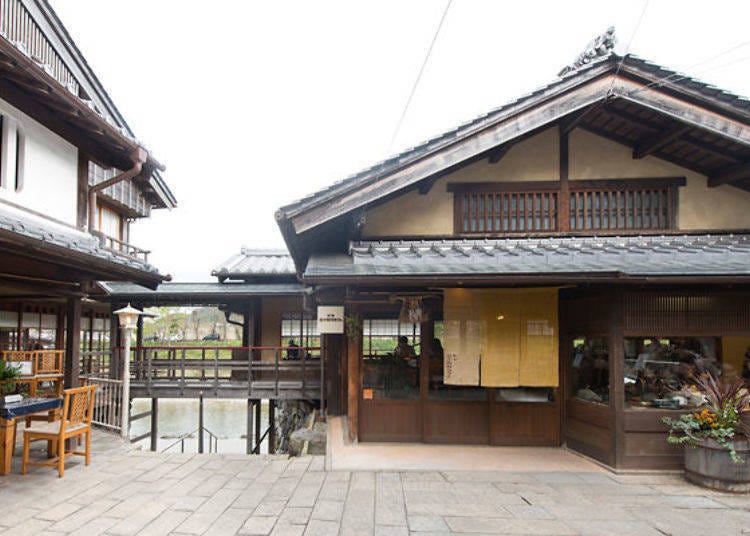
This lovely building in the style of an old-style house sits on the Isuzu River. It has excellent coffee, cakes, and zenzai (red bean soup with pieces of rice cake in it) which is only served during the winter.
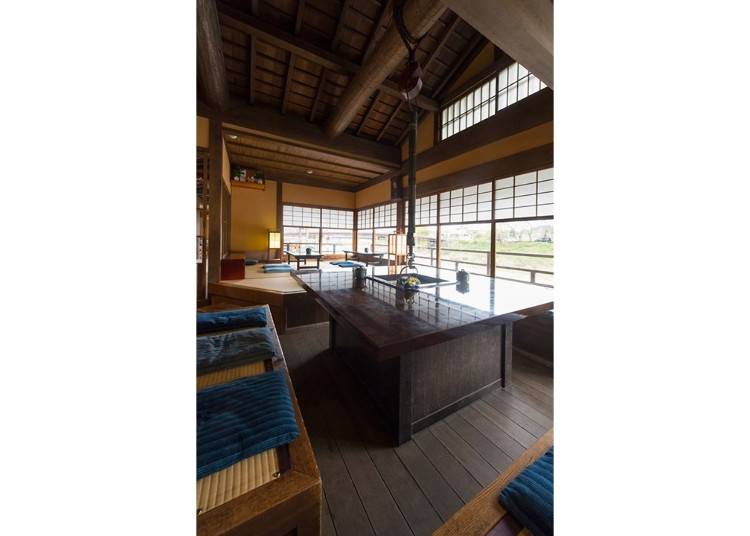
The aroma of freshly brewed coffee greets you when you enter the cafe. In addition to a counter, tables and chairs, there are also seats by the open hearth and a slightly raised tatami mat section. The atmosphere is a delightful blend of Japanese and Western.
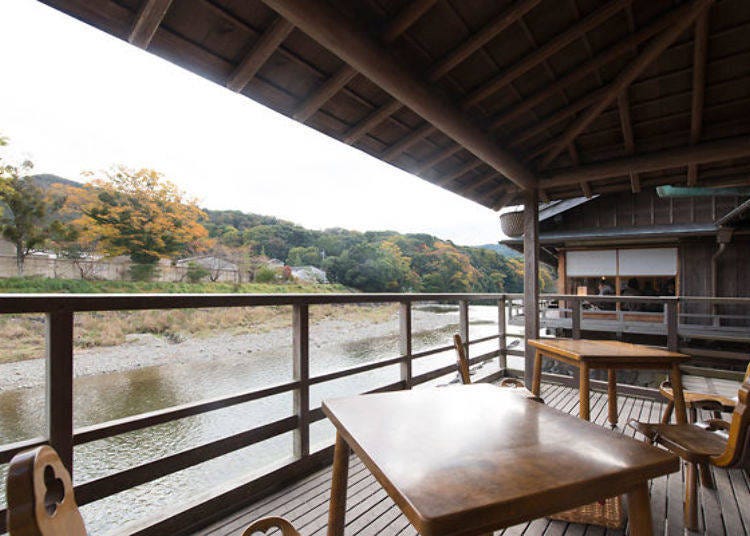
This being the season when zenzai is offered I ordered it with a coffee.
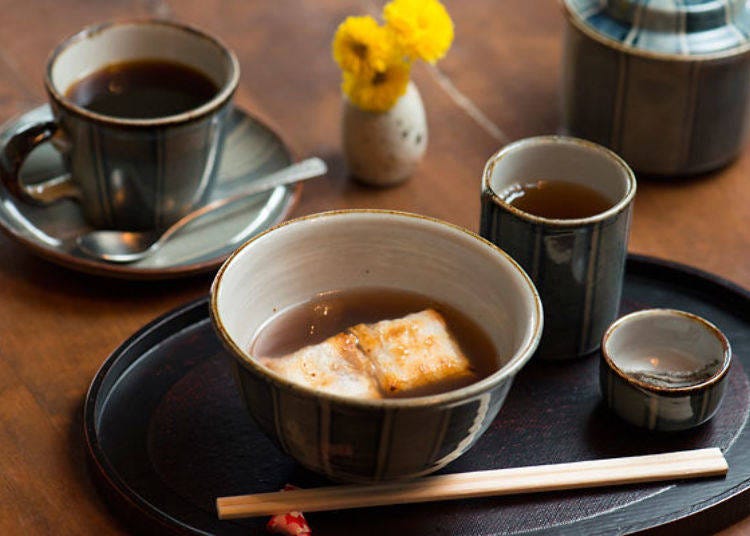
The zenzai had the beautiful color of adzuki beans. Floating in it were slightly grilled small rice cakes. The steam rising from the bowl whetted my appetite.
“Ahhh. It warmed me all through,” I sighed unconsciously. Not too sweet, it had a familiar taste that warmed my cold body. The rice cake was simple, yet was firmly evident. It went perfectly with the soup.
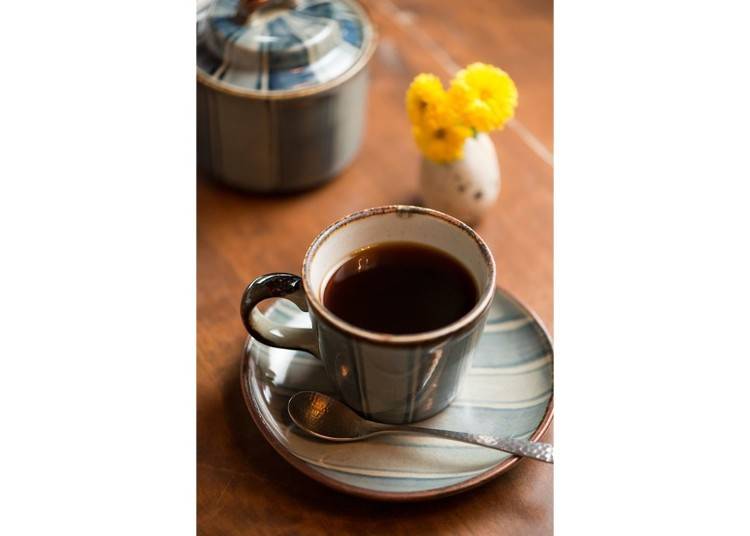
And the coffee. The Isuzu River Cafe original coffee is made with its own roasted coffee beans. The mild blend has a mellow flavor that is easy to drink and the strong blend has a bolder, richer flavor that is slightly bitter. I ordered the mild blend.
It was indeed easy to drink. While it had a distinct bitter coffee flavor it was still mild, as its name implied, and was very delicious.
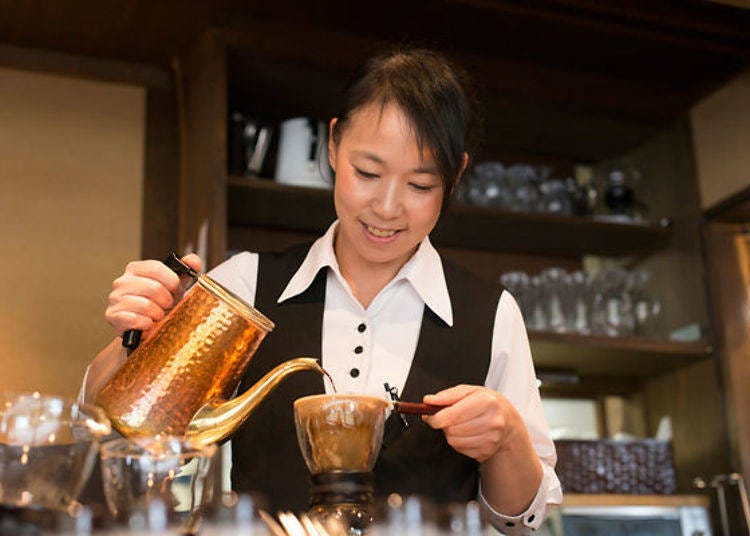
If you go to the Ise Grand Shrine for your first visit of the New Year, afterwards stop by the Isuzu River Cafe for a rest and enjoy the zenzai and coffee. It will warm your body and soul.
-
The Isuzu River Cafe五十鈴川カフェ
- Address 12 Ujinakanokiri-cho, Ise City, Mie Prefecture (inside Okage Yokocho)
- Phone Number 0596-23-9002
Open: 9:00 a.m. ~ 5:00 p.m. (L.O. 4:30 p.m.) (times may vary according to the season)
* Please ask about hours of operation: during the New Year’s holidays.
Closed: Open daily
Text by: Advision
*This article was originally published in December 2019. Prices and hours may have changed. Please check with official websites before visiting.
- Area
- Category
*Prices and options mentioned are subject to change.
*Unless stated otherwise, all prices include tax.
Popular Tours & Activitiess
Recommended places for you
-
Goods

Yoshida Gennojo-Roho Kyoto Buddhist Altars
Gift Shops
Nijo Castle, Kyoto Imperial Palace
-

ISHIDAYA Hanare
Yakiniku
Kobe, Sannomiya, Kitano
-

Tenryu-ji Temple
Temples
Arashiyama, Uzumasa
-

Kambei Sannomiyahonten
Yakiniku
Kobe, Sannomiya, Kitano
-

Jukuseiniku-to Namamottsuarera Nikubaru Italian Nikutaria Sannomiya
Izakaya
Kobe, Sannomiya, Kitano
-

Kanzenkoshitsuyakinikutabehodai Gyugyu Paradise Sannomiya
Yakiniku
Kobe, Sannomiya, Kitano
-

Kyoto's Hidden Treasures Open This Winter! Enjoy Exclusive Access to 15 Rare Cultural Sites (Jan-Mar 2026)
by: Guest Contributor
-

Everything You Need to Know About teamLab Biovortex Kyoto (2025 Insider Guide)
by: Wemmy Chau
-

New Way to Reach Koyasan! Ride Nankai's 'GRAN Tenku' for a Heavenly Journey
by: Guest Contributor
-

Celebrate a Dreamy Barbapapa Christmas at JR Osaka Station's Twilight
by: Guest Contributor
-
Ad

Experiencing Manga as Culture, Not Just Reading It: Expo 2025 with Rumiko Takahashi
-
Ad

Discover Timeless Beauty: Kimono-en, a Web Magazine Exploring the Spirit of Kimono
Inspiration for Accommodations
-

Spacious Family Hotel in Namba: 20 Comfortable Stays for Family Fun
-

Charming Hotels to Enjoy the Spectacular Views of Arashiyama's Autumn Leaves from Your Room
-

Experience Stunning Views of Osaka Castle from Private Spaces: Top Hotels Near Osaka Castle
-

Recommended by Visitors! Arashiyama's Best-Rated Hotels
-

Family-Friendly Universal Studios Japan Hotel with Excellent Access
-

Enjoy a Comfortable Stay in Osaka! 10 Hotels with Convenient Airport Shuttle Services
-

Top 10 Recommended Hotels Near Namba Station with Great Access
-

Enjoy Night Views from Your Room! Recommended Hotels in Namba Area
-

8 Most Popular Shrines in Kyoto
-

Kiyomizu-dera Temple: Guide to Visiting Kyoto's Most Famous Sightseeing Spot
-

5 Must-Visit Nara Temples and Shrines: Discover the Timeless Beauty of Japan's Ancient Capital
by: WESTPLAN
-

Secrets to Shopping in Japan: Guide to Annual Sales in Japan & Where to Shop
by: Miyu Shimada
-

The Best of Japan: 11 Major Cities Every Traveler Should Visit
-

Inside Kyoto's Spectacular Sanjusangen-do Temple with 1,000 Gold Statues
- #best gourmet Osaka
- #things to do Osaka
- #what to do in kyoto
- #what to bring to japan
- #best gourmet Kyoto
- #new years in Osaka
- #what to buy in nanba
- #Visiting Osaka
- #onsen tattoo friendly arima
- #daiso
- #Visiting Kyoto
- #best japanese soft drinks
- #japanese fashion culture
- #japanese convenience store snacks
- #japanese nail trends













